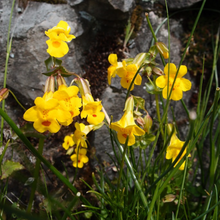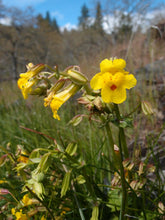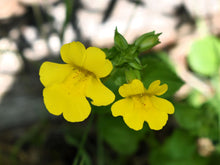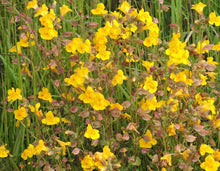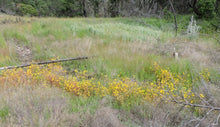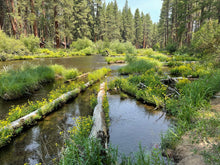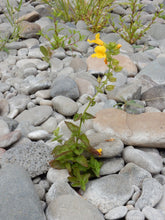
Erythranthe guttata (formerly/aka Mimulus guttatus)
Yellow monkeyflower is a highly variable plant which naturally occurs in a wide range of habitats such as wetlands, vernal pool edges and urban raingardens where its fiberous root systems improve water quality. It sports spectacularly-bright yellow, bearded flowers from late spring into summer that are favored by pollinators. With the arrival of fall, flowers mature to seeds that are eaten by small mammals and birds and dispersed readily in the garden.
- Plant type/canopy layer: deciduous, annual and perennial, herbaceous plant
- Size at maturity: 6-36" tall (varies widely depending on conditions), 1-3' wide
- Light requirements: full sun, part-sun/part-shade
- Moisture requirements: moist to wet soil
- Bloom time: April - September
- Growth rate/ease: fast growing, easy to grow
- Wildlife support: seeds are food for small mammals and birds; flowers attract and provide nectar to hummingbirds, adult butterflies, bees and other insect pollinators; this plant also attracts and supports beneficial and other pest eating insects and is a caterpillar host plant and larval food source for native butterflies and moths
- Native habitat/range: common in bogs, fens, wetlands, vernal pool edges and moist to wet forest openings across much of western North America, from Alaska to California and east to the northern Great Plains. Portland Plant List - yes.
- Special features & uses: hummingbird and pollinator favorite; deer resistant; landscape uses include pollinator gardens, raingardens and meadowscapes
Gardening with Yellow Monkeyflower: This plant will thrive in sunny no-fuss locations that have naturally moist to seasonally wet soils of nearly any kind, such as a raingarden or wet meadow. In the natural world, it is often found near streams, seeps or vernal pools that are seasonally wet but dry out by summer and where they effortlessly create a sweet, diminutive groundcover. It can even grow with its roots submerged, and its foliage and flowers floating on the surface of the water. Its stature ranges considerably based on sunlight and soil conditions. Thin soils and summer drought can keep this plant more diminutive, whereas rich garden soil and excessive supplemental water will produce a leggier, more aggressive population. Deadhead for a better appearance, to prolong blooming, or to minimize seed dispersal. Unwanted plants can be easily pulled or dug up and shared with family and friends.
Companion Plants: Try it with other plants that thrive in moist to wet soil such as red twig dogwood (Cornus sericea), Pacific ninebark (Physocarpus capitatus) and Douglas spirea (Spiraea douglasii) in the shrub layer and Willamette Valley gumweed (Grindelia integrifolia), common camas (Camas quamash) and various Carex and Juncus species in the herbaceous layer.
Seed Sowing Instructions:
- Can be fall or spring sown. Fall-winter sown seed may not germinate until temps warm in the spring. Spring sown should germinate within a couple of weeks.
- Scatter seeds at a rate of 60 seeds/sq ft on loose-weed free soil. Alternatively, you can seed a VERY small "pinch" per pot or directly in situ. Sowing in situ vs. pots tends to produce sturdier, more robust plants.
- Leave the seeds on the surface of the soil. Do not rake in.
- In pots outside, protect from heavy rains so seed does not get washed away and water gently.
- Keep soil moist.
-
Each seed packet contains approximately 25000 seeds (appear like dust)
Photo Credits 1-3 (flowers): Nikkie West, Sparrowhawk Native Plants
Photo Credit 4 (with flowers and seed heads): © Alex, some rights reserved (CC-BY)
Photo Credit 5 (in meadow): © Alex, some rights reserved (CC-BY)
Photo Credit 6 (in a river): © Henrik Kibak, some rights reserved (CC-BY)
Photo Credit 7 (on rock): © Ed Alverson, some rights reserved (CC-BY)







